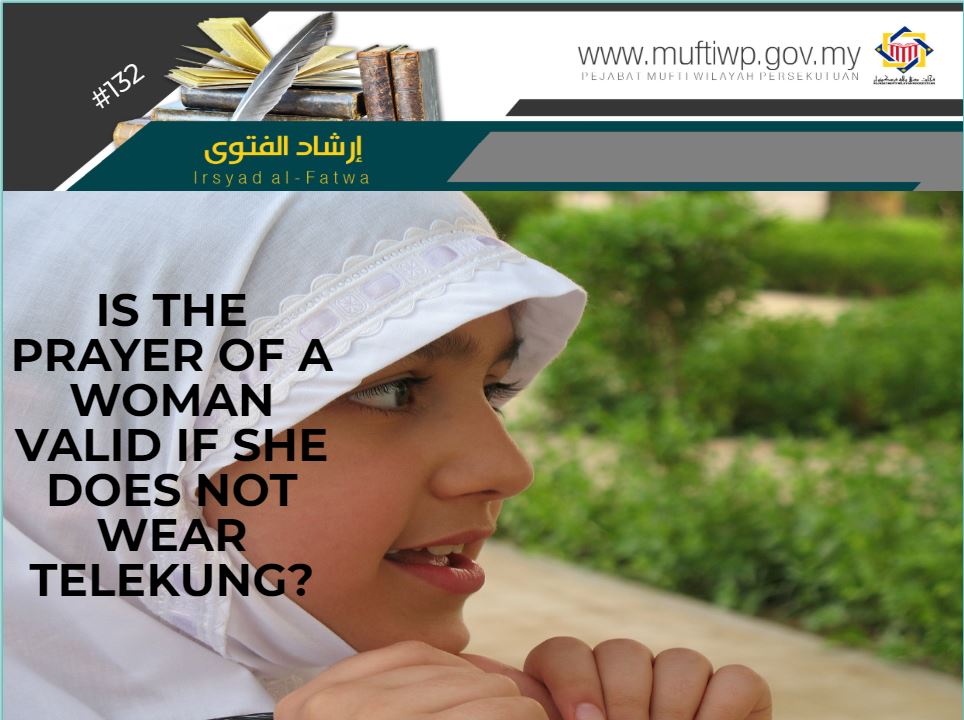Question:
Is the prayer of a woman valid if she does not wear telekung?
Answer:
Alhamdulillah, praise and thanks to Allah for the many countless blessings He has blessed us all with. Blessings and salutations to the Prophet Muhammad PBUH, his wives, his family, companions and all those that follow his teachings to the day of judgement.
The issue asked is closely related to the valid conditions of prayer discussed extensively in fiqh books. One of the valid conditions of prayer is covering one’s aurah, both for man and woman. However, in this discussion we will focus on the aurah of a woman.
Woman’s Aurah in Prayer
In al-Majmu’, al-Imam al-Nawawi stated that covering aurah in prayer is obligatory according to the consensus of scholars, whether it is in front of others or alone.
As for the aurah of woman in prayer, scholars of mazhab Syafi’e said it is her whole body except her face and hands; from fingers up to the wrists. [1] this is in accordance with Allah SWT’s statement:
وَلَا يُبۡدِينَ زِينَتَهُنَّ إِلَّا مَا ظَهَرَ مِنۡهَاۖ
“Do not expose their adornment except that which [necessarily] appears thereof,”
Surah al-Nur (31)
Ibn Abbas R.Anhuma and ‘Aisyah R.Anha explained that the phrase إِلَّا مَا ظَهَرَ مِنۡهَاۖ means face and hands. [2]
The aurah of woman in front of other ajnabi men (Muslim or non-Muslim) outside of prayer is the same as when she is praying; which are all parts of her body except the face and hands.
‘Aisyah R.Anha narrated a hadith from the Prophet PBUH:
لاَ تُقْبَلُ صَلاَةُ الْحَائِضِ إِلاَّ بِخِمَارٍ
“The solat (prayer) of a woman who has reached the age of menstruation is not accepted without a Khimar (covering of the head),”
Sunan al-Tirmizi (277)
The above hadith is an evidence for the obligation of women to cover their heads for prayer. Thus, the obligation of covering her whole body is greater.
In another hadith, ‘Aisyah R.Anha narrated an incident where women during the time of the Prophet PBUH would went out to join the congregational prayer with the Prophet PBUH:
لَقَدْ كَانَ رَسُولُ اللَّهِ صَلَّى اللهُ عَلَيْهِ وَسَلَّمَ يُصَلِّى الْفَجْرَ، فَيَشْهَدُ مَعَهُ نِسَاءٌ مِنَ الْمُؤْمِنَاتِ مُتَلَفِّعَاتٍ فِى مُرُوطِهِنَّ ثُمَّ يَرْجِعْنَ إِلَى بُيُوتِهِنَّ مَا يَعْرِفُهُنَّ أَحَدٌ
“Allah's Messenger (ﷺ) used to offer the Fajr prayer and some believing women covered with their veiling sheets used to attend the Fajr prayer with him and then they would return to their homes unrecognized.”
Sahih al-Bukhari (365)
The above hadith indirectly tells us of how the women during the time of the Prophet PBUH dressed themselves when they went to pray and went back home unrecognized by anyone.
The Ruling of Praying Without Wearing Telekung
According to the above discussion, the ruling for the prayer of a woman praying without wearing telekung is valid as long as she covers her aurah.
We are not denying that telekung covers the aurah of a woman completely as stated by syarak, however if a woman has already covered her aurah, then it is not necessary for her to wear telekung to perform her prayer.
This issue arises when wearing telekung is considered as one of the valid conditions of prayer when it is not so. The valid condition for prayer is covering aurah.
It should be reminded that covering aurah means wearing loose clothing which does not reveal the shape of the body, not wearing thin or see-through clothing that will make the skin colour visible and covering the chest and feet. Furthermore, the aurah of a woman is the same while she is praying or when she is in front of other ajnabi men outside of prayer.
May this explanation give us understanding and may Allah SWT bless us with the ability to practise it in our daily lives.
Wallahua’lam.


